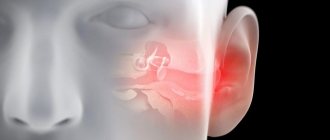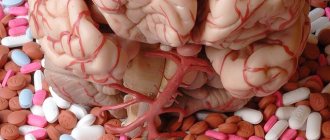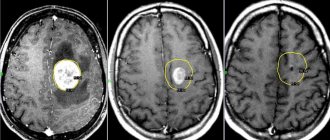Definition and Features
It is necessary to distinguish between true dizziness, in which there is a feeling of objects moving in space. Such symptoms may be normal if they occur after prolonged rotation around its axis (on a carousel), but in other cases they indicate a malfunction of the vestibular apparatus. The difficulty in diagnosing this condition is that the doctor has to rely only on the patient’s testimony. Many people also mean other symptoms by this term: impaired visual acuity, headaches and others. In reality, dizziness should be understood as a feeling of movement of environmental objects in relation to a person, while the body position is felt as stable. Most often these are circular movements (objects rotate around a person’s axis), but they can also be linear (a feeling of falling or rising in height, various shocks).
What should be considered dizziness?
Dizziness
is one of the most common complaints among adult patients; most often they only complain of headache or back pain.
However, dizziness can mean completely different symptoms. Patients often call dizziness:
- darkening of the eyes
after a sudden change in position; - a veil before my eyes
; - presyncope (feeling of impending loss of consciousness). In this case, they usually complain of dizziness and weakness;
- imbalance
(instability and
staggering when walking
); - feeling of faintness
, a state reminiscent of intoxication. In this case, the complaint usually sounds like nausea and dizziness.
Dizziness
Such symptoms are certainly significant and may indicate various diseases (anemia, low blood pressure, vegetative-vascular dystonia, diseases of the cardiovascular and respiratory systems), but are not dizziness itself. True vertigo
(or
vertigo
) is a condition in which the patient has a feeling of rotation of actually stationary objects around him or, conversely, a false sensation of his own rotation or movement. Quite often it is accompanied by nausea, vomiting, and increased sweating.
Anatomy and mechanism of development of pathology
With dizziness, there is a growing lack of coordination of movements and balance. To find out its cause, one must understand how the transmission of nerve impulses that play a role in proprioception occurs. This term refers to a person’s ability to identify and sense the position of parts of his own body relative to each other and objects in the environment. Information is perceived by proprioceptor organs, including muscle tissue, and then moves along peripheral nerves to the spinal cord, from where it enters the brain. The necessary picture is formed in the parietal lobe of the brain after nerve impulses pass through the thalamus.
The inner ear is an organ that is responsible for a person's ability to maintain balance. It has a complex structure and consists of several sections: the vestibule, 3 semicircular canals and the cochlea. The inner ear is protected by bone tissue that forms the temporal lobe of the skull. It is filled with aqueous fluid - it moves when a person tilts and turns his head, and this information is perceived by sensitive cells to identify the position of the body in space.
The nervous system collects information that comes from the visual apparatus, tactile receptors and other sensory organs, as well as from the inner ear, and then analyzes it. The center of balance is located in the cerebral cortex, namely in its temporal region. Along the nerves, impulses reach the vestibular nuclei - clusters of nerve cells capable of perceiving, analyzing and coordinating information received from different areas.
Dizziness is a disturbance in the sense of balance. Anatomically, it can occur at several levels:
- peripheral - in case of disturbance of impulse conduction at the level of the vestibular nerve or inner ear (organ of balance);
- intermediate - the pathological process is localized at the stage of transmitting information from the inner ear to the central nervous system;
- central - associated with diseases of the brain, in which it is unable to analyze the information received.
Clinical signs of dizziness of different origins do not differ. The patient experiences a feeling of disorientation in space and abnormal movement of environmental objects. However, short-term loss of balance cannot be a consequence of serious diseases of the cerebral cortex. Such dizziness is accompanied by a number of additional symptoms and occurs after injury or certain diseases. To diagnose the cause and mechanism of development of this symptom, doctors at the Clinical Institute of the Brain carry out a comprehensive examination to determine accompanying symptoms.
Causes of dizziness
Control over the position of the body in space is ensured by the joint action of three anatomical systems of the body:
- vestibular. The vestibular apparatus is located deep in the skull and includes sensitive receptors that respond to the movement of the body in space;
- visual. The eyes provide basic information about our position in relation to objects in the world around us and the position of parts of our body in relation to each other.
- peripheral sensory receptors found in muscles, joints and bones, which also provide the brain with information about the position of various parts of the body.
Stimulation of one or more of these systems can lead to dizziness (as, for example, dizziness occurs as a result of riding on a merry-go-round). If dizziness appears without any external reason, then the nature of such dizziness is obviously pathological. Most often, the cause of true (or, as it is also called, systemic) dizziness is a violation of the vestibular apparatus.
Forms of dizziness
To more accurately determine the cause of dizziness, there are several classifications of this symptom. This distribution is necessary to understand the danger of the disease and to prescribe an effective treatment regimen. Various types of therapy can be carried out by doctors of different specialties. Thus, the first classification distinguishes two types of dizziness: systemic and non-systemic.
- Systemic dizziness is a more dangerous type, which in any case indicates pathology. It is associated with a violation of nerve conduction at the level of the vestibular apparatus (inner ear, vestibular nerve, parts of the cerebral cortex). Systemic dizziness can be central, intermediate or peripheral, depending on the location of the pathological process.
- Non-systemic dizziness is also called physiological. It manifests itself in the absence of pathological changes in the vestibular apparatus, but may be a consequence of its excessive irritation. Thus, non-systemic dizziness is one of the clinical signs of motion sickness syndrome, and also occurs after a long and monotonous rotation around its axis.
Symptoms of dizziness may vary. In this regard, it is also customary to distinguish several of its varieties:
- tactile - the patient experiences a sensation of loss of support under his feet, instability, as on a ship;
- proprioceptive - associated with a change in the identification of the body in space, with a feeling that the body is rotating around an axis, and the surrounding objects remain in their places;
- visual - visually the human body remains motionless, and the environment begins to move in different projections.
It is worth understanding that systemic dizziness manifests itself in a more vivid clinical picture. It is associated with damage to neural connections, so symptoms appear and remain even without an apparent reason. In addition, loss of balance is accompanied by other characteristic manifestations of damage to the nervous system or analyzer systems. Non-systemic dizziness is temporary and can go away spontaneously as soon as the vestibular system adapts to environmental changes. The second case does not pose a danger to humans.
Etiology and pathogenesis of dizziness
Providing balance is possible by integrating the activities of the vestibular, proprioceptive, visual and tactile systems, which are closely connected with the cerebral cortex and subcortical formations. Histamine, which acts on histamine receptors, plays a critical role in the transmission of information from the receptors of the semicircular canals. Cholinergic transmission has a modulating effect on histaminergic neurotransmission. Thanks to acetylcholine, it is possible to transmit information from receptors to the lateral vestibular nuclei and the central parts of the vestibular analyzer. It has been proven that vestibulovegetative reflexes function due to the interaction of cholinergic and histaminergic systems, and histamine and glutamatergic pathways provide vestibular afferentation to the medial nucleus.
Main causes of the symptom
Dizziness can be a symptom of a number of diseases and pathological conditions that lead to disruption of the vestibular apparatus. These are congenital or acquired disorders of varying severity, with different mechanisms of development and characteristics of clinical manifestations. Among the most common groups of causes of this symptom are the following:
- inflammatory diseases of the inner ear and vestibular nerve - can be of infectious or non-infectious origin;
- intoxication and poisoning, which lead to disruption of the vestibular apparatus;
- traumatic brain injuries - when certain areas of the cerebral cortex are damaged, dizziness may appear after a long time;
- metabolic disorders, including diabetes.
Impaired balance and coordination of movements in space can also be a variant of the norm. In some cases, intense irritation of the vestibular apparatus occurs (on a carousel, during a long stay on a ship or on another unstable support), after which the nervous system needs time to recover. It is impossible to determine the cause of dizziness at home, especially if it is a consequence of organic lesions of the central nervous system.
Dizziness during menstruation and menopause
Women have their own reasons for dizziness. They are associated with hormonal changes in the body during PMS, menopause or pregnancy. The rapid loss of hemoglobin by the female body during menstrual periods often leads to anemia and lack of oxygen in the brain. It is these reasons that lead to dizziness, depression, and sudden changes in mood. With the advent of menopause, a woman’s body undergoes serious changes, which are accompanied by pressure surges and increased excitability of the autonomic nervous system.
Clinical picture of different types of dizziness
The main clinical manifestation of dizziness is a feeling of loss of balance and imaginary movement of the body in space. However, this symptom may indicate a number of different disorders, the symptoms of which will differ. At the Clinical Brain Institute, you can undergo a full examination using laboratory and instrumental techniques that will allow you to detect all possible diseases that cause dizziness. However, even an initial examination and medical history will clarify the picture and make a preliminary diagnosis. Systemic dizziness, as a manifestation of functional disorders of the vestibular apparatus, should be considered separately from non-systemic dizziness, which does not pose a danger and can even be considered a variant of the norm.
Systemic dizziness
Systemic dizziness includes a number of diseases associated with various disorders of the conduction of nerve impulses to the cerebral cortex. The pathological process can be located at any level, and therefore the symptoms will differ. Thus, each pathology that may underlie the mechanism of development of dizziness should be considered separately. Systemic types occur in no more than a third of patients and require more detailed examination.
- Benign paroxysmal positional vertigo (BPPV) is the main cause of systemic varieties. The process is associated with the formation and deposition of crystals of calcium carbonate salts on the tissues of the semicircular canals of the inner ear. This is an acquired chronic disease, the leading clinical sign of which is short-term dizziness and loss of orientation in space. The attacks last no more than 1 minute, with no additional symptoms (headache, tinnitus).
- Inflammation of the vestibular nerve (vestibular neuronitis) is a dangerous condition that often develops against the background of a bacterial or viral infection. Its reproduction with damage to the nervous system causes a characteristic set of symptoms, which includes dizziness. The duration of their manifestation ranges from several hours to several days, and their intensity remains high or even intensifies. Hearing is preserved in vetibular neuritis.
- Post-traumatic dizziness is complete or partial disorientation that develops immediately after a traumatic brain injury. The process is associated with damage to areas of the cerebral cortex responsible for transmitting information about the position of the human body in space. Clinical signs may vary in intensity and persist until the tissue has completely healed, and in some cases they appear several days after the injury.
- Intoxication is another cause of dysfunction of the vestibular apparatus. Toxins, including aminoglycosides, can accumulate in peri- and endolymph, the fluid that fills the structures of the inner ear.
- Meniere's disease is a disease in which there is an increase in the amount of endolymph (hydrops). The fluid is located in the lumen of the labyrinth of the inner ear, and an increase in its volume leads to excess pressure on its walls. The disease occurs in attacks, the interval between which can range from several days to several months. The duration of one attack is from several hours to a day, and the symptoms are very pronounced. The patient experiences acute disorientation in space, dizziness and headaches. The disease progresses and causes gradual deterioration of hearing (usually a unilateral phenomenon), but complete loss does not occur.
- Temporal lobe epilepsy is a pathological condition that is manifested by a periodically manifested complex of autonomic disorders (dizziness, headache, low blood pressure, and others). The patient's condition deteriorates suddenly, for no apparent reason, and the attack may be accompanied by deterioration of vision.
- Lipotymic conditions are a set of symptoms that precede fainting. The patient experiences severe dizziness, weakness, his skin and mucous membranes turn pale, and his heartbeat becomes less frequent. An attack can occur for many reasons, including diseases of the cardiovascular system, a decrease in blood glucose concentration, an increase or decrease in blood pressure.
Systemic dizziness most often occurs in old age, but can also occur in young people. The development of the disease should be monitored over time, taking into account the frequency and intensity of attacks. It is also important to monitor the occurrence of additional signs: hearing and vision impairment, fainting, nausea, migraines. These data will make it possible to determine the severity of violations even before specific analyzes are carried out.
Non-system varieties
One of the most characteristic signs of non-systemic dizziness is that its clinical manifestations intensify if you close your eyes. The causes of this condition may be various dysfunctions of the cerebellum and other structures that regulate motor activity and coordination of movements. Additional clinical signs include general weakness and drowsiness, decreased visual acuity, deterioration of memory and attention. Similar symptoms may occur with systemic use of certain groups of drugs (benzodiazepines). The patient's condition in such cases improves by adjusting the dosage of medications.
Symptoms of dizziness and balance problems
People who experience dizziness often describe their condition as follows:
- feeling of body movement;
- loss of balance and body tilt to one side;
- feeling of tension, squeezing in the head;
- falling for no reason;
- unsteady gait or loss of her confidence.
Symptoms may only become more pronounced when changing body position or rotating the head. Dizziness can come on suddenly and be so severe that you need to sit or lie down quickly. It can last a day or even several, although more often it is limited to a few minutes.
Diagnostic methods
The Clinical Brain Institute has all the conditions for a full diagnosis of dizziness. The process is carried out by analyzing the work of the vestibular apparatus and the brain, after which the localization of the pathological process and its stage can be detected. During the initial examination, it is important to conduct a detailed interview with the patient and obtain a detailed description of the complaints. At this stage, it is possible to differentiate true dizziness from other conditions that are also often called by this term. Next, specialists will select an individual diagnostic scheme, which may include the following steps:
- examination of the spinal column (analysis of X-rays, CT or MRI) to identify osteochondrosis, vertebral displacements and other pathologies that cause impaired blood supply to parts of the brain;
- examination by a neurologist, which includes determination of nystagmus, various tests and assessment of the ability to coordinate movements;
- examination of the state of the brain using MRI or CT - carried out to exclude tumors and other diseases leading to demyelination of nerve fibers;
- electroencephalography is a way of assessing brain activity by capturing the signals it produces;
- study of the functioning of the vestibular apparatus - may include rotational tests, vestibulometry and other tests.
Instrumental techniques are prescribed after a general examination. Based on the data obtained, the doctor can determine what examinations need to be performed in order to conduct a differential diagnosis and exclude possible causes of dizziness. Thus, if Meniere's disease is suspected, patients are offered a test to detect low-frequency sound signals.
Diagnosis and differential diagnosis
To diagnose dizziness, a neurologist must first confirm the fact of dizziness, since patients often put a different meaning into the concept of “dizziness” (headache, blurred vision, etc.). To do this, in the process of differential diagnosis between dizziness and complaints of a different nature, the patient should not be prompted for one or another term or offered to choose from. It is much more correct to hear from him a detailed description of the existing complaints and sensations.
Much attention should be paid to the neurological examination of the patient (CN condition, detection of nystagmus, coordination tests, identification of neurological deficit). However, even a full examination does not always make it possible to determine the diagnosis; for this purpose, monitoring the patient over time. In such cases, information about previous intoxications, autoimmune and inflammatory diseases may be useful. A patient with dizziness may need consultation with an otoneurologist, vestibulologist and examination of the cervical spine: radiography, MRI of the spine.
Using MRI of the brain, it is necessary to exclude neoplasms, demyelinating process and other structural changes of a congenital and acquired nature. The presence of infectious diseases can be confirmed or refuted by the determination of antibodies to the suspected pathogens, as well as a full study of the cellular composition of the blood. The diagnosis of Meyer's disease is supported by improved perception of low frequencies when recording an audiogram. You should also remember about the EEG of the brain, which allows you to exclude epileptic and paroxysmal activity in the temporal leads. A study of the vestibular analyzer is also carried out: vestibulometry, stabilography, rotational tests, etc.
Treatment and prognosis
Specialists at the Clinical Brain Institute will select the most effective treatment regimen, depending on the diagnostic results. In most cases, dizziness does not pose a threat to the life and health of the patient and is easily corrected with general measures and medication. Thus, the following methods of treating the causes and clinical signs of this condition may be recommended:
- constant monitoring of blood pressure indicators, if necessary, taking antihypertensive drugs;
- preventing the appearance of edema - limiting salt intake, prescribing diuretics (diuretics);
- taking vestibulics - drugs to eliminate the symptoms of dizziness;
- if necessary - antihistamines, anti-epileptic drugs;
- restoration of movement coordination with special exercises.
Dizziness is not a disease, but one of the symptoms of a dysfunction of the vestibular apparatus. It is impossible to determine its cause at home, so if it occurs, it is worth undergoing a comprehensive diagnosis at the Clinical Brain Institute. It employs broad and specialized specialists who regularly examine and treat patients with similar symptoms. The medical center also has the opportunity to undergo complex examinations using high-quality equipment necessary to make a diagnosis. Despite the fact that dizziness alone is not a dangerous symptom and cannot threaten the patient’s life, it can indicate serious problems with the vestibular system and organic lesions of the central nervous system in the early stages. It is impossible to cure these pathologies on your own, but an integrated and competent approach in a hospital setting will eliminate both the causes and manifestations of dizziness.
Clinical Brain Institute Rating: 4/5 — 14 votes
Share article on social networks
Treatment of dizziness
Treatment of vestibular neuronitis
Once diagnosed, the patient is hospitalized, but sometimes outpatient treatment is acceptable.
In either case, treatment should be aimed at reducing the degree of dizziness, stopping vomiting and accelerating vestibular compensation.
Symptomatic therapy includes taking vestibular suppressants. For vomiting, injectable forms of drugs are used. The duration of treatment is determined by the complexity of the manifestations of dizziness. However, in most cases they are taken for no longer than 3 days. An additional effect is provided by a course of corticosteroids and antiviral drugs for middle ear infections.
The vestibular apparatus is best stabilized through special gymnastics. At first it may have a negative impact on your well-being, but after 2-3 days the therapy should stabilize the condition. You need to repeat gymnastics at least twice a day.
Tumors of the cerebellopontine angle (acoustic neuroma)
A fairly rare cause of dizziness. It manifests itself as slowly progressive hearing loss and tinnitus. Rotational vertigo is rare, but instability is common. For some time, vestibular disorders may be the only symptom of the disease.
After this, hearing impairment begins to occur. People with this problem need to undergo an MRI of the brain with IV contrast. This will help check the patient for the presence of a tumor in the posterior cranial fossa. If a tumor is found, patients need to consult a neurosurgeon to be referred for surgery.
Rice. 7. Acoustic neuroma
Vertebrobasilar insufficiency and cerebrovascular diseases
It is distinguished by the development of reversible dysfunction of the brain stem, cerebellum and other structures into which blood enters through the basilar and vertebral arteries. Ischemic attacks can manifest themselves due to violations of their patency. The reason is atherosclerotic changes, vascular hypoplasia. Slightly less often, inflammation, extravasal compression of the vertebral artery (in case of neck injury) or artery dissection become a prerequisite.
The key cause of loss of coordination in dizziness
There are problems in the functioning of small arteries with high blood pressure, diabetes mellitus, or two diseases together.
According to statistics, cerebrovascular disorders account for about 6%. The cause of dizziness at normal pressure
can be problems in the functioning of both the labyrinth itself due to problems with blood circulation, and disturbances in the area of various brain systems.
Most patients with vertebrobasilar insufficiency are diagnosed with other neurological symptoms. Separately, dizziness with problems with blood vessels is very rare. In such situations, further diagnosis is required to remove other associated factors.
You should not associate attacks of dizziness when changing the position of your head with compression of the vertebral arteries. Often, the rapid development of severe dizziness along with nausea, vomiting and increased blood pressure can be perceived as a signal of the development of cerebrovascular disease. But it usually increases due to severe dizziness and stress.
If a stroke is suspected, a person must be urgently hospitalized for examination and immediate treatment. In the hospital, an MRI of the brain is performed, which in case of a stroke will show focal damage to the cerebellum or brain stem.
Vestibular migraine
Rice. 8. Aura during migraine
Vestibular migraine is diagnosed quite rarely, although it is regarded as a common cause of recurrent non-positional vestibular vertigo. Its manifestations are dizziness of varying severity combined with migraine and weakness. It can occur both during migraine attacks themselves and in the intervals between them.
The duration of such attacks is from 3–5 minutes to 2–3 hours, sometimes days. They are not accompanied by noise or ringing in the ears, or hearing loss. Such attacks usually recur. The diagnosis of vestibular migraine is made based on the typical clinical picture, as well as in the presence of migraine and after excluding other possible causes of dizziness in women
and men.
Treatment of the disease, as with ordinary migraine, includes 3 stages: elimination of provoking factors, relief of the attack and preventive measures. To eliminate vestibular migraine, take anti-migraine drugs or analgesics, as well as vestibular suppressants. Prevention is necessary for regular and severe attacks of vestibular migraine. Then specialists prescribe β-blockers and tricyclic antidepressants.
Demyelinating diseases (multiple sclerosis)
It happens that dizziness is diagnosed in people with demyelinating lesions of the central nervous system, especially with multiple sclerosis. Diagnostic difficulties may arise when dizziness develops at the onset of the disease without other manifestations or when they are of moderate severity. Dizziness in this case can be of a mixed nature, and can also be characterized by a persistent course. To confirm the diagnosis, the patient needs to undergo an MRI of the brain with IV contrast.
Treatment of multiple sclerosis
The most important thing in treating this diagnosis is the elimination of life-damaging sensations and accompanying disorders: difficulties with coordination, hearing or vision. Treatment is determined by the cause of dizziness in men
and women and the mechanisms of its development. It is important to guarantee the patient’s almost complete independence in everyday life, try to avoid sources of stress and minimize the risks of falls and injuries.
Symptom management includes the use of vestibulolytics. The time of taking them should be short and discussed with a doctor, because inhibition of nerve formations does not allow compensatory changes to develop. The effectiveness of treatment increases with regular exercise and exercises to restore stable functioning of the vestibular apparatus.
Therapy is also important to improve coordination, stabilize gait, and develop skills in a person to avoid problems with balance in the future. Usually, physical therapy is used for this, which not only reduces discomfort, but also gives independence when moving.
Diagnostics
Since dizziness can be a symptom of many different diseases, you should consult a doctor if it occurs. Initially, you should consult a therapist who will prescribe OAC, OAM, a blood sugar test and will be able to exclude or confirm the simplest causes of dizziness. If they do not show changes, the doctor, based on the characteristics of the manifestation of dizziness, will refer the patient to a neurologist. You may also need to additionally consult a cardiologist and an ENT specialist.
At the initial appointment, the doctor initially collects anamnesis. He is interested in when and under what circumstances attacks occur, their duration, the nature of the sensations and the presence of accompanying symptoms. After this, an inspection is carried out. First of all, the presence and nature of nystagmus (involuntary oscillatory movements of the eyeballs), gait disturbances with open and closed eyes are assessed, and the Romberg test is performed to determine the degree of stability. To perform it, you need to stand up, put your feet together, close your eyes and stretch your arms in front of you. Normally, a person maintains balance, does not stagger or fall.
Patients are also asked to undergo several tests:
- Dix-Hallpike test - the patient sits on the couch, and the doctor turns his head 45° to the side, quickly positions him so that his head hangs over the edge of the couch, and carefully monitors the eyes and the pattern of changes in nystagmus. The patient himself must report his feelings. The test is repeated with the head turned in the opposite direction.
- Halmagi-Kerthoys test - the patient fixes his gaze on a certain point on the doctor’s face. The specialist, holding his head with both hands, sharply turns it at a small angle in any direction.
- Marching test. The patient closes his eyes and stretches his arms in front of him. In this position, he needs to take about 50 steps in place with his knees raised high. After this, it is assessed how far it has moved from its original position.
- Orthostatic test - the patient lies on the couch, and the doctor measures blood pressure. After this, he needs to stand up sharply. The pressure is re-measured immediately and then after 3 minutes.
As a rule, the data obtained as a result of such an examination is sufficient to establish the cause of dizziness. But if it indicates the possibility of developing pathologies of the spine or cardiovascular system, the following are additionally prescribed:
- CT;
- MRI;
- Ultrasound of the vessels of the neck and head;
- audiometry;
- ECG;
- Ultrasound of the heart;
- stabilography.
Treatment with folk remedies
Fans of alternative medicine and folk remedies have their own recipes for relieving attacks of dizziness. The following are considered effective in these cases: ginger tea, carrot, beet and pomegranate juices. Drinking small portions of parsley seed tea throughout the day will stop the attack. Tea is brewed at the rate of 1 teaspoon of seeds per glass of boiling water and infused for 6-8 hours. Mint, lemon balm, linden blossom - teas made from these medicinal plants also have a positive effect in the treatment of dizziness.
Attacks of dizziness, as such, do not pose any threat to human life. However, in some cases they can indicate serious illnesses. And therefore, if, along with dizziness, symptoms such as severe headache, loss of sensation in the limbs, incoherent speech, and confusion are observed, you should urgently call an ambulance.
Primary appointment with a neurologist: 1850 RUR.
Sign up Online 5% discount when registering from the site
Severe dizziness: 6 dangerous reasons
In some cases, vertigo signals the development of severe conditions that require immediate medical attention. Causes of severe dizziness may include:
- Labyrinthitis (internal otitis). A viral infection in the inner ear may be asymptomatic at first. The only sign of otitis media is dizziness, which lasts for several minutes. Such attacks are repeated quite often. In the future, the viral process can affect the nervous system or brain.
- Concussion . Sometimes after a head injury, only dizziness appears. This symptom should not be ignored. It serves as direct evidence of a concussion. To eliminate the risk of swelling or serious brain damage, you should immediately seek medical help.
- Stroke . If dizziness is accompanied by sudden weakness, complaints of numbness of a body part, visual impairment, speech disturbances, then the risk of stroke is high. This is a severe pathology in which blood circulation in the brain is disrupted.
- Migraine . Dizziness accompanied by a severe headache may indicate a migraine. Many people believe that this condition is harmless. But doctors say that migraine, especially in an advanced state, can lead to severe damage (sometimes even to a heart attack or stroke).
- Cardiovascular diseases . Such pathologies are characterized by the appearance of dizziness every time a person gets up. It is caused by a sharp decrease in pressure. Symptoms like these may indicate dehydration, which is causing your blood to thicken. But if the problem is not fluid deficiency, then it may be the development of arrhythmia or heart failure.
- Tumors . Regular attacks of vertigo combined with headaches, usually in one side of the head, can signal the development of a tumor in the brain.
Non-vestibular vertigo
Disturbances in the functioning of internal organs that are not directly related to the vestibular analyzer can also be accompanied by dizziness of various types. Moreover, the features of their manifestation help determine the cause of the disorder.
Thus, a feeling of rapid loss of consciousness, lasting from a few seconds to a couple of minutes and passing after a person sits down or lies down, most often occurs when:
- pathologies of the cardiovascular system, including arrhythmias, hypertension, cardiomyopathy, heart failure, myocardial infarction;
- depression;
- anemia (decreased number of red blood cells and hemoglobin in the blood);
- diabetes mellitus;
- malnutrition.
Also, a pre-fainting state can develop with arterial orthostatic hypotension (a sudden decrease in blood pressure when suddenly getting up from a bed or sofa). This is due to a decrease in the tone of blood vessels, but in general does not pose a danger.
Chronic dizziness, imbalance, changes in walking with the appearance of a drunken gait, uncertainty when standing are more typical for older people and are a consequence of the development of one or several of the following diseases:
- heart failure;
- myocardial infarction;
- arthritis;
- stroke;
- diabetes;
- hypoglycemia;
- depressive states.
Sometimes problems with maintaining balance and dizziness occur while taking antihypertensive, antituberculosis, antiparkinsonian drugs, aminoglycoside antibiotics, antidepressants, or alcohol abuse, smoking.
Persistent postural-perceptual vertigo (PPPG), which was previously called psychogenic, is most often caused by a past history of a disease that affects the functioning of the vestibular analyzer, for example, inflammation of the vestibular nerve, Meniere's disease, concussion, etc. Thus, it is typical for a person who has already recovered and is largely due to anxiety about his condition. PPPG is typically characterized by a feeling of fog in the head and swaying when walking, but no impairment of coordination is objectively detected. Although symptoms may persist for several months, various environmental factors, from moving objects to crowds, can trigger or intensify an attack.










